'You Are Loved': UMass Amherst grad completes 100th meaningful mural
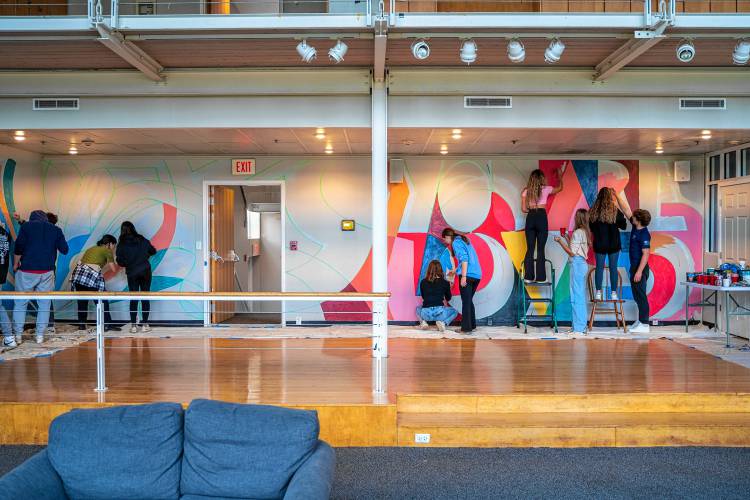
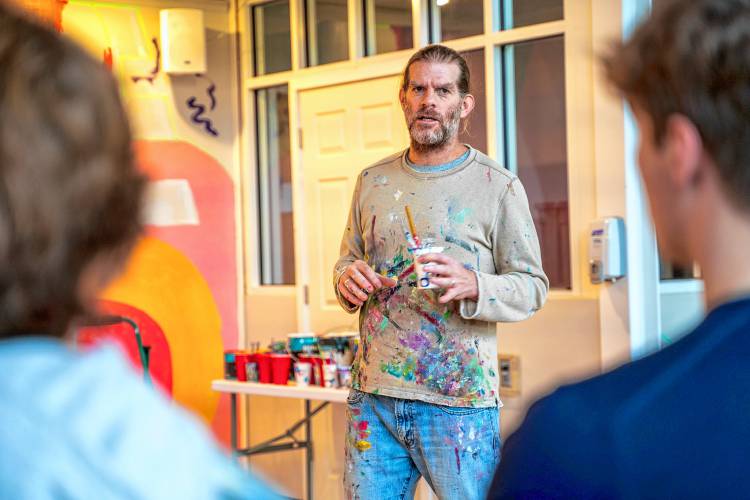
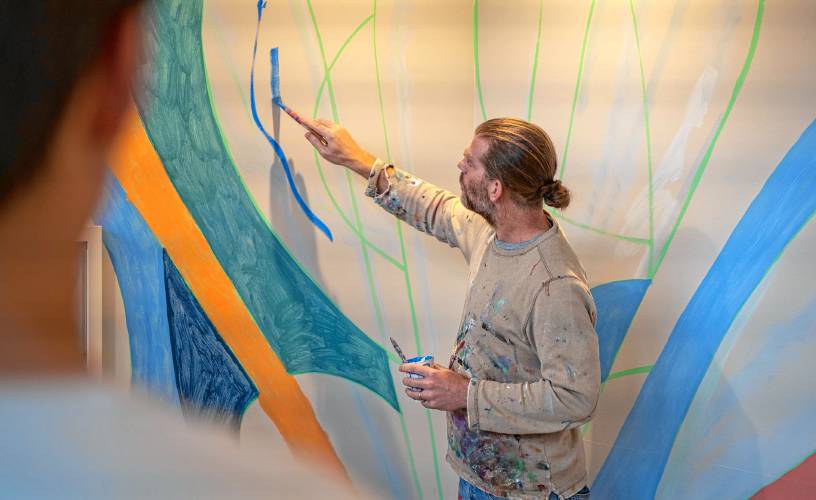
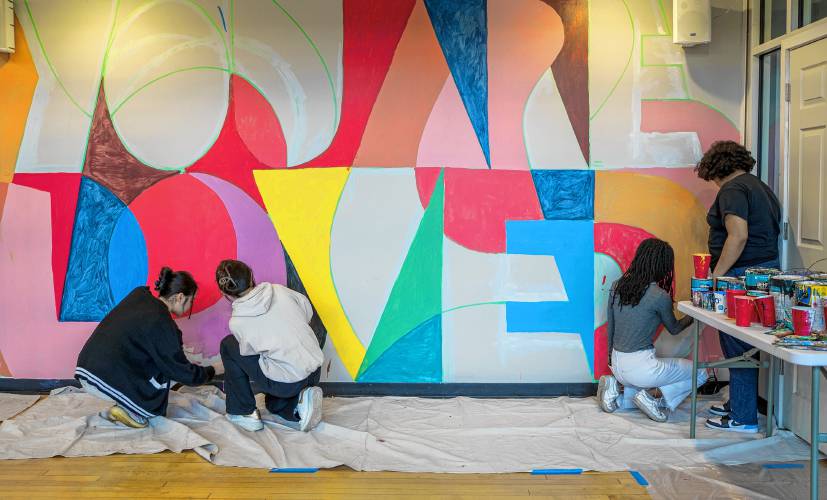
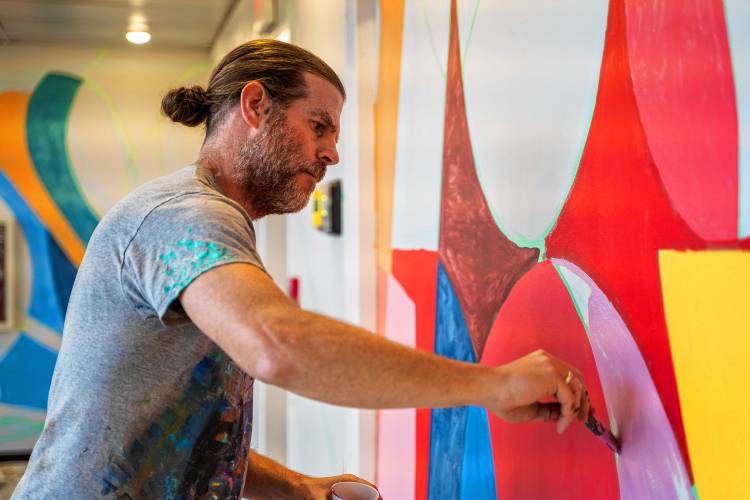
By MELISSA KAREN SANCES
For the Bulletin
Monday, December 26, 2022
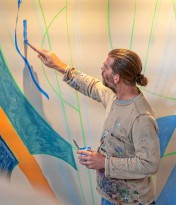
Last summer, retired art instructor Bob Callahan strolled through downtown Burlington with his family. And then he saw it. Across the street, in cool-toned letters that spanned the brick wall: “You Are Loved.”
He recognized it immediately. Not because he'd seen a mural like this before, but because the message was familiar. He'd taught the artist at Wellesley High School. He was sure of it. Next to the ocean-blue and violet block letters, he saw a carefully printed message: “For victims of drug and human trafficking.” And in the corner, the artist's name: Alex Cook.
Alex Cook! He'd been one of his favorite students in the 1990s. He was a teacher's dream: open-hearted, kind, skilled and imaginative. He waved over his son Roan, the current art teacher at Middlesex School in Concord. They stopped in front of Ben & Jerry's while Roan Callahan messaged Cook on Instagram.
They'd soon discover that this was one of many murals Cook had painted over the years. After graduating from Wellesley in 1992, he studied at University of Massachusetts Amherst, where as part of his final project he created his first three public murals in Northampton. He'd gone on to create all over the world. For the past 9 years, he had been commissioned to paint “You Are Loved” murals at schools, prisons, recovery centers and public spaces around the country. When the fall semester started, Roan Callahan would invite Cook to Middlesex, where he would paint his 100th “You Are Loved” mural.
In early December, the Callahans join Cook in the busy cafeteria at Middlesex. Once a dark, mostly grey space, it's being transformed with warm colors and a more abstract version of the artist's message. No two murals are the same. Each time he paints, he wants the rendering to “speak the language” of the words, to help them land where they are. “I think it's easy with something as basic and simple as this message, and controversial in a way, to roll your eyes and say, ‘You don't know anything,'” Cook says. “The art has the responsibility of trying to make it impossible for someone to roll their eyes.”
It's interesting how Cook's artistry makes this seemingly simple message meaningful, even acceptable. Imagining the same sentiment scrawled in black ink on the empty wall makes the words feel empty, even silly. Yet through art, Cook has made love accessible to many who have never known it.
The message originated at an elementary school in New Orleans. “One of the things we're working on as a school is helping the kids feel safe,'” the principal told him. “‘Can you make a mural that will bring that into focus?'” School, at its essence, seemed to be about love. It was a place to care for children so they could succeed. So, for the first time, he painted what would become his mantra.
“Now it's so normal to me,” he says. “But to write about love in a permanent way on a wall that wasn't, like, my bedroom, really knocked down a barrier in my thinking. Like, ‘You can do that.' From that point on, I got to do that.”
The kids at Middlesex may not have to consider safety in the same way. But just one year ago, the U.S. Surgeon General issued a national advisory on the youth mental health crisis. “I think the pandemic put a weird kind of funk over everybody,” says M'Kenzi Thompson, a senior and the student president who joins us between bells. “Things feel a lot harder than they were before.”
“This is an intense place,” says Roan Callahan, whose 100 art students happily collaborated with Cook. “The kids go to school six days a week. A lot of them are living away from their families at 14 and 15 years old. They can talk to their parents on the phone, they can FaceTime, but …” But the mural's message will always hit home.
In many ways, Bob Callahan has taught Cook about love. As a teen exploring his spirituality, Cook was in awe of Callahan's meditation practice. “I know that somewhere in like an ancient sketchbook of mine there is a drawing, like a little cartoon of you sitting like this, levitating off the ground,” he tells his former teacher with a laugh. Cook felt called to connect to a higher purpose, and Callahan taught him that art could have many meanings. In his class, Cook first identified as an artist; it was more than something he did, it was a way of being that he'd come to trust, to know in a way that his teacher already recognized. During our conversation, his mentor mostly listens, beaming like a proud parent of two sons whose stars have aligned.
As much as Cook the adolescent knew he was an artist, he didn't know how, exactly, he would stay one. Early on, it often felt like a burden, to have these “treasures,” these precious intentions, that he felt compelled to actualize, because he also had to survive.
“One mural, two murals, three murals, that's one thing,” he says. “But is that enough to make a life on and say that this is worth doing?” Twenty-five years later, the answer is yes. “You cast aside all the reasons it wouldn't work and trust that this 1 percent glimmer can turn into 15 percent, 100 percent,” one hundred “You Are Loved” murals.
That glimmer of hope is something Cook hopes to spark in everyone, especially those who haven't seen much light. One of his murals was gifted to the Oak Creek Youth Correctional Facility in Oregon, which houses girls who have experienced what Superintendent Mike Riggan terms “the poverty of indifference.” Many have been orphaned; more than half have been trafficked.
“It's a pretty noble thing to enter into the suffering of another human being,” says Riggan, who believes that recovery is as relational as apathy is lonely. Cook, who at one time worked as a chaplain, does not shrink from darkness. At Oak Creek, he collaborated with an 18-year-old with a significant trauma history and a “flair for art.” Painting was part of her healing, and Cook inspired another youth, who was recently granted clemency, to paint three murals of her own.
The mural in Burlington was in direct response to local trafficking. A few years ago, Aimee Stearns, the victim witness coordinator for the U.S. Attorney's Office in Vermont, asked Cook if he would paint one as part of the office's outreach efforts. Stearns found the ideal wall – right across from the busy Ben & Jerry's – and survivors, coworkers and the public collaborated on the project. “The best part was seeing how well the community responded to it,” she says. “While he was painting, people would be walking by and stopping to talk to him about it.”
“There's something about the scale of it, the publicness of it,” says the artist of the permanent, prominent murals that give the words time to sink in, and, hopefully, spark connection. “It means, at least to some degree, that in this space, we talk about love.”
Melissa Karen Sances recently moved to Easthampton from Boston and loves telling meaningful stories about her new home. Reach her at [email protected].
This “Eyes on Trafficking” story is reprinted from its original online location.
 ABOUT PBJ LEARNING
ABOUT PBJ LEARNING
PBJ Learning is a leading provider of online human trafficking training, focusing on awareness and prevention education. Their interactive Human Trafficking Essentials online course is used worldwide to educate professionals and individuals how to recognize human trafficking and how to respond to potential victims. Learn on any web browser (even your mobile phone) at any time.
More stories like this can be found in your PBJ Learning Knowledge Vault.
EYES ON TRAFFICKING
This “Eyes on Trafficking” story is reprinted from its original online location.
ABOUT PBJ LEARNING
PBJ Learning is a leading provider of online human trafficking training, focusing on awareness and prevention education. Their interactive Human Trafficking Essentials online course is used worldwide to educate professionals and individuals how to recognize human trafficking and how to respond to potential victims. Learn on any web browser (even your mobile phone) at any time.
More stories like this can be found in your PBJ Learning Knowledge Vault.
